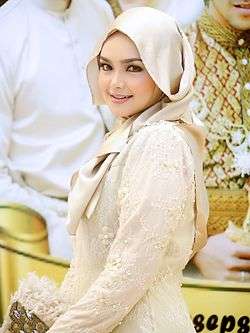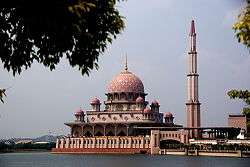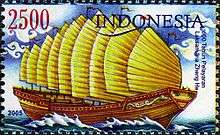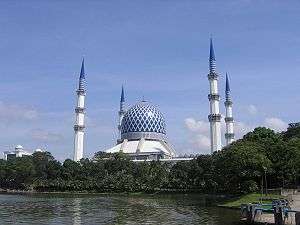Islam in Malaysia
Malaysia is a multiconfessional country whose most professed religion is Islam. As of 2013, there were approximately 19.5 million Muslim adherents, or 61.3% of the population.[1]
Islam in Malaysia is represented by the Shafi'i version of Sunni theology and jurisprudence.[2][3] Islam was introduced by traders arriving from Arabia, China and India. It became firmly established in the 15th century. The constitution grants freedom of religion and makes Malaysia an officially secular state, while establishing Islam as the "religion of the Federation" to symbolize its importance to Malaysian society.[2][3] The king is generally seen as the defender of the faith in the country.
Various Islamic holidays such as Muhammad's birthday etc., have been declared national holidays alongside Christmas, Chinese New Year and Deepavali.
Background
The draft Constitution of Malaysia did not specify an official religion. This move was supported by the rulers of the nine Malay states, who felt that it was sufficient that Islam was the official religion of each of their individual states. However, Justice Hakim Abdul Hamid of the Reid Commission which drafted the Constitution came out strongly in favour of making Islam the official religion, and as a result the final Constitution named Islam as the official religion of Malaysia.[4] All ethnic Malays are Muslim, as defined by Article 160 of the Constitution of Malaysia.[5][6]
Religion of the Federation
Nine of the Malaysian states, namely Kelantan, Terengganu, Pahang, Kedah, Perak, Perlis, Selangor, Johor and Negeri Sembilan have constitutional Malay monarchs (most of them styled as Sultans). These Malay rulers still maintain authority over religious affairs in states. The states of Penang, Malacca, Sarawak and Sabah do not have any sultan, but the king (Yang di-Pertuan Agong) plays the role of head of Islam in each of those states as well as in each of the Federal Territories of Kuala Lumpur, Labuan and Putrajaya.
On the occasion of Malaysia's first prime minister Tunku Abdul Rahman's 80th birthday, he stated in the 9 February 1983 edition of the newspaper The Star that the "country has a multi-racial population with various beliefs. Malaysia must continue as a secular State with Islam as the official religion". In the same issue of The Star, Abdul Rahman was supported by the third Malaysian Prime Minister, Hussein Onn, who stated that the "nation can still be functional as a secular state with Islam as the official religion."[7]
Currently, one of Malaysia's states, Kelantan, is governed by PAS which is a conservative Islamic political party, with a proclaimed goal of establishing an Islamic state. Terengganu was briefly ruled by PAS from 1999 to 2004, but the ruling Barisan Nasional coalition has since won back the state. To counter the falling credibility of United Malays National Organisation (UMNO)'s Islamic credentials vis-à-vis PAS, the head of the Barisan Nasional, Datuk Seri Abdullah Badawi, proposed Islam Hadhari. In the 1990s, the Pan-Malaysian Islamic Party (PAS)-led state governments passed Islamic hudud laws in Terengganu, but was struck down by the secular federal government.
The newest format of the Malaysian Identity Card (MyKad) divides Malaysians into various religious groups, e.g., Muslim, Christian, Hindu, Buddhist. The introduction of this card caused a political uproar and was deemed discriminatory by non-Muslims. This issue has, however, since abated and been accepted by non-Muslims. There is also an Islamic university in Malaysia called the International Islamic University Malaysia, and a government institution in charge of organizing pilgrimages to Mecca called Tabung Haji (Pilgrim Fund Board of Malaysia). In addition, the government also funds the construction of mosques and suraus.[8]
Although the constitution declares Malaysia to be a secular state, there is much confusion on this subject. Several Muslims have argued, especially after former Prime Minister Mahathir bin Mohamad's declaration that Malaysia is an Islamic state.
Despite the federal government's denial that Malaysia is an Islamic state, the previous administration under Abdullah Badawi have gradually furthered the agenda of Islamic supremacy at the expense of other religions. The spread of Christianity is a particular sore point for the Muslim majority. The Malaysian government has also persecuted Christian groups who were perceived to be attempting to proselytize to Muslim audiences.[9]
There is a National Fatwa Council that issue fatwas, as part of the Department of Islamic Advancement of Malaysia (JAKIM).
History
.jpg)
Individual Arab traders, including Sahabas, preached in the Malay Archipelago, Indo-China, and China in the early seventh century.[10] The Islamic Cham people of Cambodia trace their origin to Jahsh (Geys), the father of Zainab and thus one of the fathers-in-law of the Islamic prophet Muhammad. Islam was introduced to the Sumatran coast by Arabs in 674 CE.[11]
Islam was also brought to Malaysia by Indian Muslim traders in the 12th century AD. It is commonly held that Islam first arrived in Malay peninsular since Sultan Mudzafar Shah I (12th century) of Kedah (Hindu name Phra Ong Mahawangsa), the first ruler to be known to convert to Islam after being introduced to it by Indian traders who themselves were recent converts. In the 13th century, the Terengganu Stone Monument was found at Kuala Berang, Terengganu, where the first Malay state to receive Islam in 1303 Sultan Megat Iskandar Shah, known as Parameswara prior to his conversion, is the first Sultan of Melaka. He converted to Islam after marrying a princess from Pasai, of present-day Indonesia.
The religion was adopted peacefully by the coastal trading ports people of Malaysia and Indonesia, absorbing rather than conquering existing beliefs. By the 15th and 16th centuries it was the majority faith of the Malay people.
Influences of Zheng He's voyages
Zheng He is credited to have settled Chinese Muslim communities in Palembang and along the shores of Java, the Malay Peninsula, and the Philippines. These Muslims allegedly followed the Hanafi school in the Chinese language.[12] This Chinese Muslim community was led by Hajji Yan Ying Yu, who urged his followers to assimilate and take local names.
Islamic
.jpg)
Sunni Islam
The Sunni Islam of the Shafi'i school of thought is the official, legal form in Malaysia, although syncretist Islam with elements of Shamanism is still common in rural areas. Mosques are an ordinary scene throughout the country and adhan (call to prayer) from minarets are heard five times a day. Government bodies and banking institutions are closed for two hours every Friday so Muslim workers can conduct Friday prayer in mosques. However, in certain states such as Kelantan, Terengganu, Kedah and Johor, the weekends fall on Friday and Saturday instead of Saturday and Sunday. It has been introduced to several states, notably Kelantan and Terengganu, all businesses closes for 2 hours on every Friday for prayers. Failure to comply would result in fines.
All public places, including shopping malls, hotels, condominiums, usually have allocated spaces called "Surau", for performing the Muslim prayers.
Other sects
The Malaysian government has strict policies against other Islamic sects, including a ban on Shia Islam,[13] in order to "avoid violence between the two faiths that has sometimes broken out in other parts of the world by promoting only the Sunni faith"[14][15] Despite the restrictions, Malaysia is a popular choice for Arab Shia academics fleeing who are unable to obtain employment in most of the Arab states that are Sunni. There is also a large and growing Iranian population, traditionally Shia, who choose to live in Malaysia.
A notable sect that has been outlawed is Al-Arqam.[16]
Muslims who believe Mirza Ghulam Ahmad to be the fulfillment of the Islamic prophecies concerning the return of Jesus, the Ahmadiyya, are also present. There are approximately 2,000 Ahmadis in the country.[17] Though small in number, they face state sanctioned persecution in Malaysia.[18]
Muslims who reject the authority of hadith, known as Quranists, Quraniyoon, or Ahl al-Quran, are also present in Malaysia. The most notable Malaysian Quranist is the scholar Kassim Ahmad.[19]
Cultural role

Islam is central to and dominant in Malay culture. A significant number of words in the Malay vocabulary can trace their origins to Arabic which is the chosen language of Islam. This is, however, not exclusive and words from other cultures such as Portuguese, Chinese, Dutch, Sanskrit, Tamil, English, and French can also be found in the Malay language. Islam is so ingrained in Malay life that Islamic rituals are practiced as Malay culture. Muslim and Malays are interchangeable in many daily contexts.
Hari Raya Aidilfitri (Eid ul-Fitr) is an important festival celebrated by Malaysian Muslims.
Muslim women generally wear the tudung (hijab or headscarf) over their heads. However, Malay women not wearing any headgear are not reprimanded or penalised. Prominent Malaysian female examples are Datuk Seri Rafidah Aziz, International Trade and Industry Minister and Tun Dr Siti Hasmah Mohd Ali, wife of former Malaysian Prime Minister Tun Dr Mahathir bin Mohammad. However, with the influx of Arabic travellers, foreign Muslim women (Arabs) wearing hijab that leave only their eyes exposed are often spotted in tourist attractions, not the least at the shopping malls. At certain Malaysian institutions such as the International Islamic University, wearing of the tudung is mandatory; however for non-Muslim students this usually amounts to a loosely worn piece of cloth draped over the back of the head.

Some regard the tudung to be an indication of Arabic influence in Malay Muslim culture, and point to incidents such as the banning of the traditional Malay wayang kulit in the state of Kelantan (which was ruled by the Islamist PAS) to be "un-Islamic".[20]
Malaysia's top Islamic body, the National Fatwa Council, ruled against Muslims practicing yoga, saying it had elements of other religions that could corrupt Muslims.[21] The same body has ruled against ghosts and other supernatural beings. [22]
Political issues
UMNO's committee in mosque
Tan Sri Abdul Khalid Ibrahim, the 14th chief minister of the state of Selangor said, "We want mosques to carry out more activities for the Muslims. Unfortunately, the UMNO (political party) only want to put their men in the administration of mosques. This is absurd." He said he wants to replace mosque committees to reduce political interference. "We must remember, the Sultan of Selangor in his every speech has stressed against using mosques for political purposes and His Highness has been consistent in stating his views".[23]
Definition of Malay
As defined by the Constitution of Malaysia, Malays must be Muslim, regardless of their ethnic heritage; otherwise, legally, they are not Malay. Consequently, apostate Malays would have to forfeit all their constitutional privileges, including their Bumiputra status, which entitles them to affirmative action in university admissions and discounts on purchases of vehicles or real estate. It is legally possible to become a Malay if a non-Malay citizen with a Malaysian parent converts to Islam and thus claims all the Bumiputra privileges granted by Article 153 of the Constitution and the New Economic Policy (NEP). However, the convert must "habitually speak the Malay language" and adhere to Malay culture. A tertiary textbook for Malaysian studies following the government-approved syllabus states: "This explains the fact that when a non-Malay embraces Islam, he is said to masuk Melayu ("become a Malay"). That person is automatically assumed to be fluent in the Malay language and to be living like a Malay as a result of his close association with the Malays".[24]
Islam in Malaysia is thus closely associated with the Malay people, something an Islamic scholar has criticised, saying that Malaysian Islam is "still clothed in communal garb; that Muslims in Malaysia have yet to understand what the universal spirit of Islam means in reality".[25]
Sharia legal system
Parallel to the civil courts, there are Sharia courts which conduct legal matters related to Muslim family sphere. Legal issues like Muslim divorce and Muslim apostasy are conducted in the Syariah Courts. However, there are cases whereby apostasy cases are tried in the Federal Courts. Non-Muslims are not bound by Shariah.
Clothing

As of 2013 most Muslim Malaysian women wear the tudung, a type of hijab. This use of the tudung was uncommon prior to the 1979 Iranian revolution,[26] and the places that had women in tudung tended to be rural areas. The usage of the tudung sharply increased after the 1970s,[27] as religious conservatism among Malay people in both Malaysia and Singapore increased.[28]
Several members of the Kelantan ulama in the 1960s believed the hijab was not mandatory.[26] By 2015 the Malaysian ulama believed this previous viewpoint was un-Islamic.[29]
By 2015 Malaysia had a fashion industry related to the tudung.[26]
Norhayati Kaprawi directed a 2011 documentary about the use of tudung in Malaysia, "Siapa Aku?" ("Who am I?"). It is in Malay, with English subtitles available.[29]
Although wearing the hijab, or tudung, is not mandatory for women in Malaysia, some government buildings enforce within their premises a dresscode which bans women, Muslim and non-Muslim, from entering while wearing "revealing clothes".[27][30]
Distribution of Muslims
According to the 2010 Census, 61.3% of its population (17,375,794 people) were Muslim. All person who self-identifying as ethnic Malay is categorised as Muslims (see also ethnoreligious group). The data shows the non-Malay who self-identifying as Muslim does not "masuk Melayu" and still counted separately from Malay ethnic group. Information collected in the census based on respondent's answer and did not refer to any official document.
By gender and ethnic group
| Gender | Total Muslim Population (2010 Census) | Malaysian Muslim Citizens | Non-Malaysian Muslim Citizens | ||||
|---|---|---|---|---|---|---|---|
| Bumiputera Muslim | Non-Bumiputera Muslim | ||||||
| Malay Muslim | Other Bumiputera Muslim | Chinese Muslim | Indian Muslim | Others Muslim | |||
| Nationwide | 17,375,794 | 14,191,720 | 1,347,208 | 42,048 | 78,702 | 102,334 | 1,613,782 |
| Male Muslim | 8,892,853 | 7,145,985 | 679,221 | 25,108 | 42,475 | 52,776 | 947,288 |
| Female Muslim | 8,482,941 | 7,045,735 | 667,987 | 16,940 | 36,227 | 49,558 | 666,494 |
By state and ethnic group
| State | Total Muslim Population (2010 Census) | Malaysian Muslim Citizens | Non-Malaysian Muslim Citizens | ||||
|---|---|---|---|---|---|---|---|
| Bumiputera Muslim | Non-Bumiputera Muslim | ||||||
| Malay Muslim | Other Bumiputera Muslim | Chinese Muslim | Indian Muslim | Others Muslim | |||
| Nationwide | 17,375,794 | 14,191,720 | 1,347,208 | 42,048 | 78,702 | 102,334 | 1,613,782 |
| Johor | 1,949,393 | 1,759,537 | 13,068 | 4,074 | 8,318 | 5,896 | 158,500 |
| Kedah | 1,504,100 | 1,460,746 | 1,119 | 1,003 | 3,345 | 1,673 | 36,214 |
| Kelantan | 1,465,388 | 1,426,373 | 6,406 | 1,525 | 445 | 1,448 | 29,191 |
| Malacca | 542,433 | 517,441 | 2,202 | 868 | 1,678 | 963 | 19,281 |
| Negeri Sembilan | 615,235 | 572,006 | 3,651 | 1,848 | 4,626 | 1,529 | 31,575 |
| Pahang | 1,124,909 | 1,052,774 | 8,651 | 1,002 | 2,244 | 4,313 | 55,925 |
| Penang | 696,846 | 636,146 | 1,251 | 1,290 | 12,335 | 1,628 | 44,196 |
| Perak | 1,301,931 | 1,238,357 | 15,387 | 1,367 | 7,537 | 1,764 | 37,519 |
| Perlis | 203,476 | 198,710 | 202 | 369 | 260 | 499 | 3,436 |
| Sabah | 2,096,153 | 184,197 | 1,106,042 | 9,591 | 3,164 | 40,216 | 752,943 |
| Sarawak | 796,239 | 568,113 | 134,340 | 4,037 | 1,892 | 2,433 | 85,424 |
| Selangor | 3,161,994 | 2,814,597 | 23,804 | 10,241 | 24,472 | 32,829 | 256,051 |
| Terengganu | 1,004,152 | 985,011 | 1,130 | 369 | 435 | 972 | 16,235 |
| F. T. Kuala Lumpur | 776,958 | 679,236 | 5,466 | 3,838 | 7,688 | 4,886 | 75,844 |
| F. T. Labuan | 66,065 | 30,001 | 24,083 | 522 | 195 | 1,235 | 10,029 |
| F. T. Putrajaya | 70,522 | 68,475 | 406 | 104 | 68 | 50 | 1,419 |
Islam-related tourist attractions
- Islamic Arts Museum Malaysia
- Islamic Heritage Museum
- Kelantan Islamic Museum
- Malacca Al-Quran Museum
- Malacca Islamic Museum
- Malay and Islamic World Museum
- Penang Islamic Museum
See also
Notes
- ↑ "The Future of the Global Muslim Population - Malaysia", Pew Forum. 2013.
- 1 2
- 1 2 Wu & Hickling, p. 35.
- ↑ Wu & Hickling, pp. 19, 75.
- ↑ Article 160 (2). Constitution of Malaysia.
- ↑ Malay of Malaysia
- ↑ Ooi, J. 2007. "Merdeka... 50 years of Islamic State?". Accessed 21 July 2007.
- ↑ Putra, Tunku Abdul Rahman (1986). Political Awakening, p. 105. Pelanduk Publications. ISBN 967-978-136-4.
- ↑ Report by the Special Rapporteur on the
- ↑ T. W. Arnold, 1913/1997, The Preaching of Islam, Delhi: L.P. Publications, p. 294, 294 nt.2; Dru C. Gladney, Hui Muslims in The South Asian Studies, California, vol.16, No.3, August 1987, page 498, p.498 nt.8.
- ↑ W.P. Groeneveldt, 1877, Notes on the Malay Archipelago and Malacca, Batavia : W. Bruining.
- ↑ AQSHA, DARUL (13 July 2010). "Zheng He and Islam in Southeast Asia". The Brunei Times. Retrieved 28 September 2012.
- ↑ "Rights Group Says Six Malaysians Detained For Being Shia Muslims", Islam Online. Accessed August 13, 2007.
- ↑ "Iraqi Sunnis forced to abandon homes and identity in battle for survival", "The Guardian". Accessed April 5, 2015.
- ↑ Fernandez, Celine (December 15, 2013). "Malaysian Shia Muslims Prepare for Trial". Wall Street Journal.
- ↑ Morgan, Adrian. "Malaysia: Heretical Islamic cult returns", SperoNews. Accessed August 13, 2007.
- ↑ "Malaysia's Ahmadis living dangerously". November 8, 2011. Retrieved May 31, 2014.
- ↑ http://www.thepersecution.org/world/my/09/09/tng29.html
- ↑ Aisha Y. Musa, The Qur'anists, 19.org, Retrieved July 6, 2013.
- ↑ Kent, Jonathan (August 6, 2005). "Malaysia's clash of cultures". BBC.
- ↑ "Top Islamic body: Yoga is not for Muslims", CNN, November 22, 2008
- ↑ "Malaysia issues fatwa on ghosts", Aljazeera English
- ↑ "Khalid Expects 'More Serious' Agenda In Audience With Sultan". Bernama. 5 July 2008. Archived from the original on 19 April 2014. Retrieved 19 April 2014.
- ↑ Shuid, Mahdi & Yunus, Mohd. Fauzi (2001). Malaysian Studies, p. 55. Longman. ISBN 983-74-2024-3.
- ↑ Wu, Min Aun & Hickling, R. H. (2003). Hickling's Malaysian Public Law, p. 98. Petaling Jaya: Pearson Malaysia. ISBN 983-74-2518-0.
- 1 2 3 Boo, Su-lyn. "Tudung industry in Malaysia: Cashing in on conservative Islam" (Archive). The Malay Mail. May 9, 2015. Retrieved on August 28, 2015. See version at Yahoo! News. "Nik Abdul Aziz Nik Hassan, former Universiti Kebangsaan Malaysia (UKM) lecturer in history and dakwah, said Muslim women in Malaysia started donning the tudung in the 1970s.[...]it’s considered wrong,” he added, estimating that more than 70 per cent of Muslim women in Malaysia wear the headscarf."
- 1 2 Leong, Trinna. "Malaysian Women Face Rising Pressure From Muslim 'Fashion Police'" (Archive). Huffington Post. July 21, 2015. Retrieved on August 28, 2015. "Malay women began adopting conservative styles of dress in the 1970s, reflecting a growing politicization of religion in the Islamic world. Many now wear the headscarf that in earlier decades had been worn mostly in conservative backwaters."
- ↑ Koh, Jaime and Stephanie Ho. Culture and Customs of Singapore and Malaysia (Cultures and Customs of the World). ABC-CLIO, 22 June 2009. ISBN 0313351163, 9780313351167. p. 31.
- 1 2 Fernandez, Celine. "Why Some Women Wear a Hijab and Some Don’t" (Archive). The Wall Street Journal. April 18, 2011. Retrieved on August 28, 2015.
- ↑ Hassim, Nurzihan (2014). "A Comparative Analysis on Hijab Wearing in Malaysian Muslimah Magazines" (PDF). SEARCH: The Journal of the South East Asia Research Center for Communications and Humanities. 6 (1): 79–96. ISSN 2229-872X. Retrieved 2 December 2015. (Archive)
External links
| Wikimedia Commons has media related to Islam in Malaysia. |
| Wikinews has related news: Multifaith council commends Malaysian politician's comments on conversion to Islam |
- IslamGRID project by Department of Islamic Development Malaysia (Jakim)
- Department of Islamic Development Malaysia (Jakim)
- Jakim.TV: Islamic TV by Department of Islamic Development Malaysia (Jakim)





